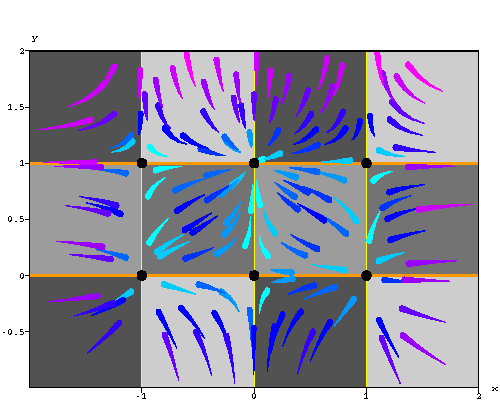
| Answers |
|---|
Problem 1. Consider the system

Draw the nullclines and find all equilibrium points. Determine the fate of the solutions with initial conditions
![]()
Problem 2. Find the solution of

with the initial condition
![]()
Problem 3. Find the solution of

with the initial condition
![]()
Problem 4. Consider the system

Find the equilibrium points. Find the linearized system at these
points and discuss the behavior of the solutions at these points.
Determine if the equilibrium points are sinks, saddles, sources, and
so on...
Answers.
Answer to Problem 1. Let us find the x-nullclines and
y-nullclines.
![]()
which is equivalent to x = 0 or -4x-y+1 = 0.
![]()
which is equivalent to y = 0 or ![]() (which is the
equation of a circle centered at (0,0)).
(which is the
equation of a circle centered at (0,0)).
The critical points are the intersection between the x-nullclines and y-nullclines. Hence the equilibrium points are
![]()
See the figure below for more details about the nullclines and the
solutions.
 |
![]()
Answer to Problem 2. The matrix coefficient is
![]()
The characteristic equation is
![]()
Its roots are : -3 and -3 (-3 is a double root). An eigenvector associated to -3, is
![]()
We may choose
![]()
The general solution is
![]()
where
![]()
satisfies
![]()
This gives ![]() . Hence the vector
. Hence the vector
![]()
will do (here we took ![]() ). Hence the general solution is
). Hence the general solution is
![]()
The initial condition Y(0) = (1,0) gives
![]()
This implies ![]() and
and ![]() . Therefore the solution to the
initial condition is
. Therefore the solution to the
initial condition is
![]()
Answer to Problem 3. The matrix coefficient is
![]()
The characteristic equation is
![]()
Its roots are
![]()
(these are complex roots). An eigenvector associated to 4 + 2i, is
![]()
We may choose
![]()
WE need the real part and imaginary part of
![]()
Easy calculations give
![]()
where
![]()
and
![]()
The general solution is
![]()
The initial condition Y(0) = (1,1) gives
![]()
which yields
![]()
This implies ![]() and
and ![]() . Therefore the solution to the
initial condition is
. Therefore the solution to the
initial condition is
![]()
Answer to Problem 4. Let us find the x-nullclines and
y-nullclines.
![]()
which is equivalent to x = 0 or ![]() . This gives
. This gives
![]()
![]()
which is equivalent to y = 0 or y = 1.
The critical points are the intersection between the x-nullclines and y-nullclines. Hence the equilibrium points are
![]()
In order to find the linearized system at these points, we must find the Jacobian of the system which is
![]()
Therefore, we have
![]()
The eigenvalues are 1 and -1. Therefore, (0,0) is a saddle.
![]()
The eigenvalues are 1 (which is double). Therefore, (1,1) is a source.
![]()
The eigenvalues are -1 and -2. Therefore, ![]() is a sink.
is a sink.
![]()
The eigenvalues are 1 and -2. Therefore, ![]() is a saddle.
is a saddle.
See the figure below for more details on the behavior of some
solutions.
 |

Math Medics, LLC. - P.O. Box 12395 - El Paso TX 79913 - USA